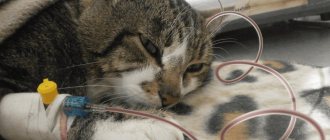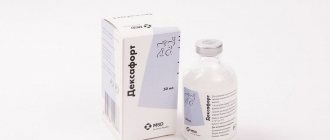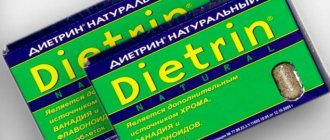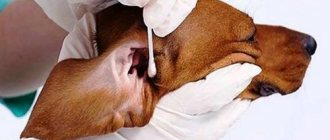general description
Furinaid (original name Furinaid) is produced in the form of a gel. The light brown transparent gel is packaged in plastic bottles. Each bottle is equipped with a special dispenser, which greatly simplifies the use of the medicine. To measure the required amount of the drug, just press the dispenser 1-2 times. The volume of the bottle is 150 ml. This amount, when used for one animal, is enough for three full courses.
No special conditions are required to store the drug. It is enough to place the bottle of gel in a dry place away from sunlight. And although the drug is considered safe, it should still be stored away from food and feed intended for pets. The air temperature should be between 5 and 25˚C. Do not allow the gel to freeze, as this may lead to loss of its medicinal properties.
Action and features
Due to hypothermia, poor nutrition and other reasons, urological pathologies often occur in cats. Usually the diseases are accompanied by pain, problems with urination and other unpleasant symptoms. This requires long-term and complex treatment, but Furinaid can significantly speed up the pet’s recovery.
The composition of the drug includes N-acetiglucosamine. This substance is part of the cells that form a protective layer in the bladder. It serves as a kind of “building material” or foundation for the formation of new cells. With regular intake of the substance into the body, regeneration processes are accelerated, resulting in the restoration of the bladder mucosa. During the inflammatory process, the protective layer of this organ is damaged, the tissues become susceptible to the effects of irritating factors, and this entails pain and other symptoms. With the restoration of the mucous membrane, the unpleasant symptoms of pathologies of the genitourinary system also disappear.
Since the drug contains N-acetiglucosamine in the form of a gel, it is quickly absorbed in the gastrointestinal tract. In the animal's body, it interacts with hyaluronic acid, which is present in the epithelium and other tissues. The substance is well tolerated by pets, is not addictive and does not have negative toxic effects.
Furinide for cats is an effective remedy in the treatment of urological diseases
Cats often suffer from urological diseases, most often cystitis or urolithiasis. Factors that provoked an unpleasant condition could be hormonal imbalances, poor nutrition or hypothermia.
It is not easy to cure an animal from such an illness; this will require a set of measures, including drug therapy.
For what diseases is Furinide used?
Furinide for cats is considered an effective drug in the treatment of urological diseases, and is available in pharmacies without a prescription. However, it can only be used after consultation with a specialist.
The drug Furinide is prescribed for urological diseases of cats.
The main advantage of the drug is that it can be used not only for treatment, but also as part of the prevention of the following diseases:
- urological syndrome;
- cystitis;
- urolithiasis;
- infectious diseases of the genitourinary system.
Reference. The treatment regimen and dosage are prescribed individually, depending on the disease and the characteristics of the cat’s body. In addition, the goals that are pursued when prescribing a drug - treatment or prevention - are also important. The instructions for use of the medication contain only a list of general recommendations.
Composition and release form of the drug
The drug is available in the form of a transparent light brown gel, packaged in 150 ml plastic bottles. For ease of use, the container with the medication is equipped with a dispenser.
The main active ingredient of the drug is N-acetylglucosamine. When you press the dispenser once, approximately 150 mg of the medicinal composition is released.
Mechanism of action and properties of the medicinal product
The action of the drug is aimed at restoring the functions of the urinary tract and treating urological diseases of various origins.
N-acetylglucosamine forms a protective film on the mucous membrane of the bladder, which helps protect the organ from negative effects. The medicinal mass is absorbed into the blood through the gastrointestinal tract and is quickly absorbed. The active components attach to damaged tissues, increasing their resistance and blocking inflammatory processes.
The drug Furinide restores the function of the genitourinary organs.
In addition, the remedy allows you to compensate for the lack of glycosaminoglycans in the animal’s body, which is the cause of the development of various urological diseases, and prevent the disorder.
Instructions for use for cats
The medicinal gel should be used in accordance with the following recommendations:
- Give the drug to the cat by mixing it into the food.
- For the first 14 days, the daily volume should be 2.5 ml, which corresponds to pressing the dispenser twice.
- After 2 weeks, the dose of the medication is reduced to 1.25 ml per day, which corresponds to pressing the dispenser once.
- The daily volume is given to the animal once, and is not divided into several doses.
- Drug therapy is required for 3-4 weeks.
- When treating urological diseases, courses should be repeated several times a year.
Important! During therapy, it is necessary to provide the cat with round-the-clock access to drinking water, since the drug can provoke a feeling of thirst, and even slight dehydration leads to a deterioration in the general condition and frequent urination.
Are there any contraindications and side effects?
Rare cases of allergic reactions in cats have been identified as side effects. There are no contraindications to the use of the drug.
If during the treatment any changes in the behavior or well-being of the animal are noticed, you must immediately stop taking the medicine and seek advice from a specialist.
The drug has no contraindications for use.
Shelf life and storage conditions
The shelf life of the drug is 2 years. The medicinal product must be stored in a dry and cool place, at a temperature of 5 to 25 degrees, away from pets and children. The medicine is not intended for storage in the refrigerator; under such conditions it loses its medicinal properties.
Reviews from breeders about the drug
Victor. I had to treat my pets with this drug, and I was pleased with the result. Indeed, bladder diseases in cats are not uncommon and they suffer greatly.
But Furinide allows not only to eliminate unpleasant manifestations, but also to significantly alleviate the condition of the sick animal from the first days of use.
Now I use this drug not only for treatment, but also for preventive purposes.
Tatiana. The veterinarian prescribed Furinide to my cat, but I have some doubts about the drug. It contains chemical components, which means that the remedy is still capable of causing side effects. And although my pet has become much easier, I am closely monitoring her condition.
Source: https://cat-expert.ru/furinajd-dlya-koshek.html
When to use
According to the instructions for use, Furinide is used for cats to treat the following diseases:
- cystitis;
- infectious diseases of the genitourinary tract;
- urolithiasis;
- urological syndrome;
- other urological pathologies.
Note! The drug can be used to treat idiopathic cystitis. The peculiarity of this disease is that the inflammatory process occurs against the background of nervous shock and the influence of other external factors.
Usually the drug is used in combination with other medications. These can be antibacterial or antiviral drugs, medications whose action is aimed at eliminating symptoms. Furinide can also be used for prevention. Its use is especially important for animals that have previously had problems with the genitourinary system, as well as older pets.
Furinide for cats
> Helpful information
23.04.2020
Did you know that hormonal imbalance and hypothermia can cause urological diseases in cats?
Another factor that can trigger the development of cystitis or urolithiasis is poor nutrition. Such a diagnosis in a cat’s chart is not uncommon.
When urological problems are detected, veterinarians often prescribe Furinaid for cats. This product is produced by an Irish company. It is valued by specialists for its effectiveness and safety. Even with long-term use, the risk of complications is minimal.
pharmachologic effect
The drug Furinide is used for the treatment and prevention of diseases of the urinary system in the cat family. This is important because idiopathic cystitis occurs in 60% of animals that have been spayed or neutered. The disease is accompanied by inflammation in the bladder with fibrosis.
Furinaid is also prescribed for other pathologies, such as: Urolithiasis; Infectious diseases of the genitourinary tract; Urological syndrome. The fight against urological diseases requires long-term and complex therapy. The use of Furinide helps to significantly speed up the process.
Let us consider the pharmacological action of the drug in more detail. It contains N-acetiglucosamine. The same substance is found in the mucous membrane of the bladder. It performs protective functions. N-acetiglucosamine is the basis for the formation of new cells. Furinide is produced in the form of a gel.
Thanks to this, the medicine is quickly absorbed and absorbed by the body. From the stomach, the beneficial components of the drug enter the blood. The active ingredients are transported through the blood vessels to the bladder. There they attach to damaged areas, increasing their resistance to irritants.
This process occurs after interaction with hyaluronic acid (present in the epithelium and other tissues). Simultaneously with cell regeneration, inflammation is relieved.
The drug helps to compensate for the deficiency of glycosaminoglycans in cats, thereby preventing the occurrence of malfunctions in the urinary system in the near future. The lack of this substance in the body provokes the development of urological diseases in animals.
The drug Furinaid is sold in plastic bottles with a dispenser. In appearance it is a transparent gel of a light brown color. A volume of 150 ml is enough for 3 courses of administration. The main ingredient in the drug is N-acetylglucosamine. 100 g of medicine contains 12,500 mg of this substance. This means that with a daily intake of 1.25 ml, the cat receives 156 mg of N-acetylglucosamine.
How to use
Furinide gel is given daily along with food. You can add it to any treat that the animal loves. If the drug is used for preventive purposes for several animals, each pet should be given the medicine separately, accurately dosing the amount of gel.
The dose of the drug is calculated simply:
- For the first 2 weeks, the daily dose of the gel is 2.5 ml (two presses on the dispenser). The dose does not depend on the weight or age of the animal.
- After relief of acute symptoms of the disease, the dose is halved after 14 days. To ensure a long-lasting effect from the use of the medicine, it is given to the pet for another 14 days, 1.25 ml per day.
If a cat refuses food with gel, it is allowed to give the drug forcibly, but this creates additional difficulties for owners. A small spoon or syringe without a needle can be used for this.
Note! When using Furinide, the pet must have constant access to clean drinking water. Under the influence of the medicine, the animal develops a constant feeling of thirst. If your pet does not replenish its water needs, dehydration may occur.
Methods of application
Used for the treatment of idiopathic cystitis in cats and dogs. Today there is no general pattern for every animal. Usually a set of measures is applied. After examining the animal, taking into account the age, breed and test results, the veterinarian will prescribe the optimal dose for the use of the drug Furinide.
The medicine has the advantage of having an odor similar to that of cat food. You just need to add it to your food and check that the entire portion is eaten. If the cat categorically refuses to take Furinide, veterinarians recommend the following methods. They will help you carry out the procedure painlessly and fairly quickly.
You should wrap your cat in a towel to prevent scratches on your hands. We hold the muzzle on top with our hand. In this case, the index finger and thumb are behind the fangs. The animal's head must be positioned horizontally. To administer Furinaid we use a small spoon or syringe without a needle. After squeezing out the medicine, close the cat’s mouth, turn its nose up and stroke its neck. Gel portions should be small.
shutterstock
When treated with Furinide, a cat, especially a castrated one, should receive plenty of fluids. This will help prevent urine stagnation and further inflammation. It is worth increasing the amount of wet food.
What restrictions are there?
Furinide is a safe product for animals that has no contraindications. It can be given to pets of all ages, including old animals that may have health problems.
The gel is well tolerated by cats of different breeds, so it can be used without restrictions, although the recommended dosages should still be followed. It is necessary to refuse use only if the animal is intolerant to the components. Although in practice this is extremely rare.
Contraindications and precautions
The effects of the gel are well tolerated by representatives of the cat family. The veterinarian prescribes this dietary supplement regardless of: Gender; Breeds; Age. Side effects were identified only in isolated cases in the form of an allergic reaction to individual components of the drug. Furinaid has no other contraindications for use. Monitor your cat's condition the first time you take the drug. Sudden changes in the animal’s behavior or well-being may be a signal to stop taking the drug and contact a veterinarian for advice. These are the only precautions that need to be taken. Otherwise, the gel is absolutely safe and can be used without restrictions.
Advantages and disadvantages
The main advantages of Furinaid include the following:
- Can be used for the treatment and prevention of urological diseases.
- Combines with various medications and feeds.
- It is efficient. Owners and veterinarians note that the results of use are noticeable within a few days.
- It has no restrictions on use and can be used for animals regardless of their age, breed and weight.
- Does not cause side effects and is well tolerated by animals.
Furinide is not a panacea, but it is a good support for the animal’s body with urological diseases. The formula of the drug was developed taking into account the characteristics of the cat’s body, the mechanism of occurrence of urological diseases and other important factors.
The disadvantages include the duration of the course. When an animal independently eats the gel along with food, then this is not a problem, but it’s a completely different matter if you need to force the medicine in. Difficulties may arise when purchasing. In Moscow, St. Petersburg and other big cities it is possible to buy Furinide for cats, but in small towns it is often unavailable.
Indications for use
Furinide is prescribed to cats that suffer from various diseases of the lower urinary tract:
- urological syndrome;
- cystitis;
- urolithiasis;
- urinary tract infections.
Animals older than middle age and neutered cats are susceptible to these types of diseases. And also pets who have experienced stress, regardless of the factors. The drug is used for both treatment and prevention. Furinide helps restore the protective barrier of the urinary mucosa. The restored layer of glycosaminoglycans prevents the negative effects of urine on healthy cells.
The main symptoms of diseases in cats:
- painful symptoms when urinating;
- constant urge to urinate;
- incontinence;
- bloody discharge in the urine;
- severe pain, manifested by aggressiveness.
Owner reviews
Marina, owner of a Russian blue cat:
“We were prescribed Furinide for the treatment of cystitis in combination with other medications. Finding the gel in pharmacies turned out to be a difficult task. I had to call all the pharmacies. The price is very high, and it is difficult to judge the effectiveness. The fact is that our cat flatly refused to eat food with gel. I had to force the drug into him. This did not always work out. We successfully cured cystitis, but Furinaid’s merit is not in this.”
Ekaterina, owner of a Persian cat:
“We were prescribed this feed additive for the treatment of cystitis in our beauty. The manufacturer writes that cats eat the gel themselves, but this is not true. Our Pushinka immediately smelled a smell that she did not like. Even attempts to hide the gel deep in the food were unsuccessful. They forced him into the cat for a couple of weeks, and then asked the doctor to adjust the treatment.”
Galina, owner of a 10-year-old cat:
“Treatment of idiopathic cystitis has turned into real agony for us. The treatment gave temporary results, but upon completion of the course the disease returned. One day, an acquaintance, an avid cat lover, told me about Furinaida and advised me to try using it on my cat. Since the product has no contraindications, we started looking for it at the pharmacy. This turned out to be not an easy task; most pharmacies had not even heard of such a remedy, but we still managed to find it. The cat ate the medicine without any problems (it was mixed with canned food), and after a week her condition improved. Now we take it periodically for prevention.”
Drugs with similar effects
Pharmacists have developed analogues of the drug Furinide for cats. They help eliminate the occurrence of cystitis, regardless of etiology. Treatment is selected individually and carried out under the supervision of a veterinarian.
Let's look at the list of complex herbal remedies similar to Furinaid:
- Urinary Tract Support. Has an anti-inflammatory, diuretic effect. Relieves spasms. Promotes acidification of urine, which prevents the formation of crystalline elements;
- BLADDER SUPPORT. Prescribed for age-related dysuria, urolithiasis, prostatitis. Increases the tone of the bladder walls, normalizes metabolic processes, reduces inflammation;
- Kotervin. They are used in the treatment of urolithiasis and lower urinary tract. Helps remove salts and dissolve stones. Prevents the occurrence of inflammatory processes.
Furinide - for cats with ICC, urological syndrome, urolithiasis, genitourinary tract infections.
Feline Lower Urinary Tract Diseases (FLUTD) - disease of the lower urinary tract in cats - is one of the most pressing problems of modern veterinary medicine.
Feline idiopathic cystitis (FIC) is the most common of these diseases, affecting 65% of cats. Cystitis is an inflammatory process in the mucous membrane of the bladder that has an acute or chronic course. Sometimes the entire wall of the bladder is involved in the pathological process. ICC is characterized by symptoms of cystitis without signs of bacterial cystitis, has common symptoms with human cystitis, and is characterized by the formation of ulcerative lesions, inflammation and proliferation of connective tissue (fibrosis), regardless of the sex of the animal. Current research suggests that FCI is caused by changes in the protective layer of glycosaminoglycans (GAGs) lining the bladder.
Structure of the bladder The wall of the bladder consists of three layers. From the inside it is lined with a mucous membrane lying on a submucosal basis, followed by the muscular and outer adventitial membranes.
The mucous membrane lines the bladder, ureters and urethra. It consists of transitional epithelial cells and a GAG layer. This ensures the ability to remain intact to the action of a rather aggressive liquid - urine and prevents microbial contamination and adhesion of crystals on the mucous membrane, increases resistance to ascending microflora. Any damage to the GAG layer allows urine to penetrate the bladder wall, causing inflammation.
It has been proven that the level of GAG is an important factor in increasing the tightness of the bladder, the loss of which is the main cause of cystitis. Reduced GAG permeability leads to the development of chronic inflammatory and pain reactions and degeneration of the bladder muscles.
Most susceptible to idiopathic cystitis are:
- cats and middle-aged cats
- overweight cats
- castrated cats and female cats
- Persian cats
- animals under the influence of stress factors (transportation, weather changes, changes in habitual lifestyle).
- Both males and females are equally affected.
Clinical signs of feline idiopathic cystitis include:
- pain and difficulty urinating (dysuria)
- increased frequency and dysregulation of urination,
- up to incontinence and/or complete cessation of urination (pollakiuria)
- the appearance of blood in the urine (hematuria)
- change in behavior, loss of voiding reflex in the designated area
- aggressiveness
Restoring the GAG level is possible using FURINAID:
It has been proven that cats with interstitial cystitis have decreased GAG secretion.
Furinaid is a cat food supplement containing N-Acetyl Glucosamine (NAG). NAG provides the bladder mucosa with glycosaminoglycans, which adhere to the damaged epithelium and increase the tightness and impermeability of the bladder.
Furinaid promotes the regeneration of the urinary tract epithelium and supports the protection of the glycosaminoglycan layer.
The metabolism of NAG differs from that of other forms of glucosamine. Moreover, it provides the possibility of forming other forms of glucosamine in the chain:
D-glucosamine – NАG – GAG.
With a lack of N-Acetyl Glucosamine in the bladder, it begins to come from the liver and other organs and tissues, reducing its quantity and the possibility of regeneration of cartilage tissue.











